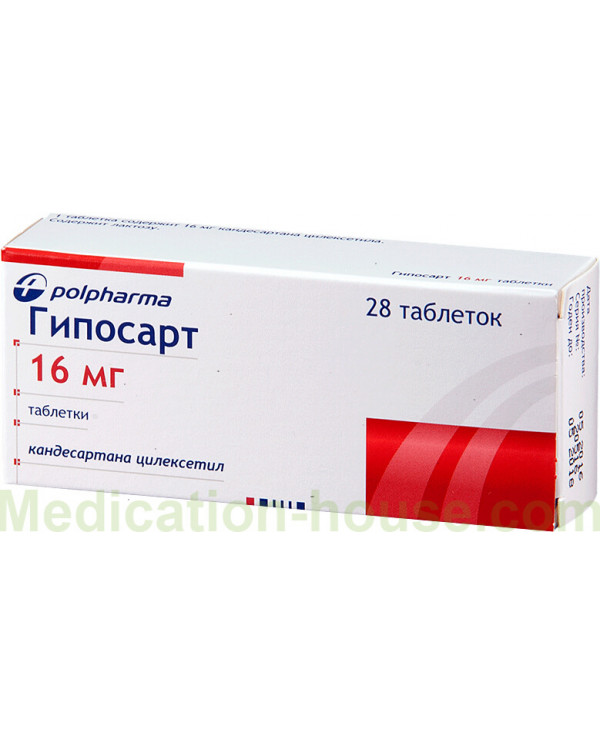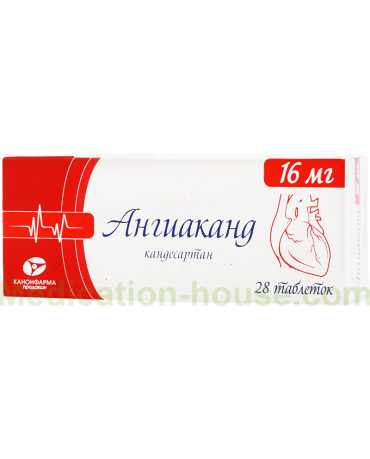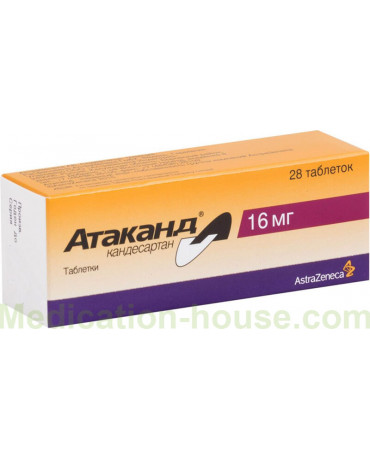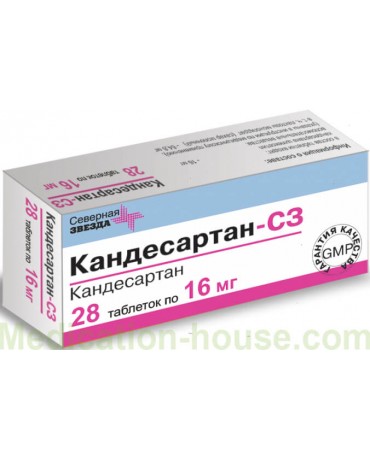Giposart instruction for use
You can buy Giposart on this page
Giposart is an angiotensin II receptor antagonist.
Release form and composition
Dosage form - tablets: round, with a dividing line on one side; light pink (4 mg) - flat, with a chamfer on each side, the presence of minor inclusions is allowed; light pink (8 mg) - small inclusions are possible, biconvex, with an engraving "8" on the other side; white (16 mg) - biconvex; white (32 mg) - flat, chamfered on both sides, engraved "32" on the other side (14 pieces in a blister: 4 mg each, in a cardboard box 1, 2 or 4 blisters; 8 mg each, 16 mg and 32 mg, in a cardboard box 2 blisters).
1 tablet contains:
active substance: candesartan cilexetil - 4 mg, 8 mg, 16 mg or 32 mg;
auxiliary components: hyprolosis [viscosity, water, 25 ° C (5%) 75–150 cps (centipoise)], hyprolosis [viscosity, water, 25 ° C (5%) 1500–3000 cps], lactose monohydrate, macrogol 6000, corn starch, magnesium stearate.
In addition, in tablets of 4 mg and 8 mg - iron oxide red dye (E172).
Indications for use
arterial hypertension;
impaired systolic function of the left ventricle (left ventricular ejection fraction less than 40%) and chronic heart failure - as part of combination therapy with angiotensin-converting enzyme (ACE) inhibitors or monotherapy - with intolerance to ACE inhibitors.
Contraindications
syndrome of glucose-galactose malabsorption, lactase deficiency, lactose intolerance;
the simultaneous use of aliskiren and aliskiren-containing agents for diabetes mellitus or impaired renal function [glomerular filtration rate (GFR) less than 60 ml / min];
severe liver dysfunction and / or cholestasis;
period of pregnancy;
breast-feeding;
age up to 18 years;
hypersensitivity to the components of Giposart.
Caution should be exercised when prescribing Giposart to patients on hemodialysis or with severe renal impairment [creatinine clearance (CC) less than 30 ml / min], bilateral renal artery stenosis or stenosis of an artery of a single kidney, in the period after kidney transplantation, with hypertrophic obstructive cardiomyopathy, hemodynamically significant stenosis of the mitral and / or aortic valve, cerebrovascular disorder of ischemic origin, ischemic heart disease, hyperkalemia with a reduced volume of circulating blood (BCC), with primary hyperaldosteronism, general anesthesia during surgery.
Method of administration and dosage
The tablets are taken orally once at any time of the day, regardless of the meal.
The recommended daily dosage for the treatment of arterial hypertension: the initial and maintenance doses are 8 mg each; in the absence of a sufficient clinical effect of Giposart, the dose can be increased to 16 mg. It should be borne in mind that the antihypertensive effect can be assessed after 4 weeks of therapy. The daily dose should not exceed 32 mg.
If, against the background of the use of even the maximum dose, it is not possible to achieve adequate control of blood pressure (BP), the additional appointment of hydrochlorothiazide or another thiazide diuretic is indicated. This will enhance the antihypertensive effect of the drug.
At risk of developing arterial hypotension, including patients with reduced BCC, the initial dose is 4 mg.
With mild to moderate renal dysfunction (CC 30–80 ml / min) and in patients on hemodialysis, the initial dose of Giposart should not exceed 4 mg. Then the dose should be adjusted depending on the therapeutic effect.
With mild to moderate liver dysfunction, the initial dose is 4 mg. Then, if necessary, it can be increased.
The recommended daily dosage for the treatment of chronic heart failure is 4 mg. To achieve the required clinical effect, the dose can be increased, taking into account the patient's tolerance to Giposart, gradually, once every 2 weeks, doubling it. The maximum daily dose is 32 mg.
In case of impaired liver and / or kidney function, elderly patients do not need to adjust the initial dose.
Side effects
on the part of the cardiovascular system: often - a significant decrease in blood pressure;
from the nervous system: often - weakness, headache, dizziness;
from the hematopoietic system: very rarely - neutropenia, leukopenia, thrombocytopenia, agranulocytosis;
from the respiratory system: often - cough, pharyngitis, rhinitis, respiratory infections;
from the urinary system: often - impaired renal function, with a predisposition - renal failure;
from the digestive system: very rarely - nausea, abnormal liver function, increased activity of liver enzymes, hepatitis;
from the musculoskeletal system: very rarely - arthralgia, back pain, myalgia;
allergic reactions: very rarely - skin rash, itching, urticaria, angioedema;
laboratory indicators: very rarely - hyponatremia, an increase in the concentration of creatinine in the blood, hyperkalemia, hyperuricemia, a slight decrease in hemoglobin;
others: flushing of the face, exacerbation of gout.
Special instructions
The undesirable effects of candesartan are transient, mild. Their frequency does not depend on the dose of Giposart or the age of the patient.
Since Giposart has a less pronounced antihypertensive effect on patients of the Negroid race than on patients of other races, when prescribing, they should increase the dose of the drug and combine the use with other antihypertensive drugs.
With severe or end-stage renal failure (CC less than 15 ml / min), careful dose selection and blood pressure control are required.
In chronic heart failure, especially in patients with impaired renal function and / or over the age of 75 years, renal function should be monitored periodically. The selection of the dose is recommended to be accompanied by monitoring the concentration of potassium and creatinine in the blood serum.
Since in the treatment of chronic heart failure, the combination with an ACE inhibitor can increase the risk of developing renal impairment and hyperkalemia, it is necessary to ensure that the patient is regularly carried out appropriate laboratory tests.
Patients on hemodialysis require individual dose selection and blood pressure control during hemodialysis.
With bilateral stenosis of the renal arteries or stenosis of an artery of a single kidney, the use of an angiotensin II receptor antagonist can contribute to the development of hyperuricemia and hypercreatininemia.
Patients with chronic heart failure may develop arterial hypotension.
BCC should be compensated if necessary.
Due to the risk of impaired renal function, caution should be exercised when combining Giposart with non-steroidal anti-inflammatory drugs (NSAIDs), especially in elderly patients. If necessary, this combination is recommended to consume a sufficient amount of fluid, to ensure control of renal function at the beginning of treatment and periodically during therapy.
With the development of severe arterial hypotension during general anesthesia, intravenous administration of vasopressors and / or fluids is required.
It is not recommended to use the drug in primary hyperaldosteronism due to the patient's resistance to antihypertensive drugs that affect the renin-aldosterone-angiotensin system.
Against the background of the use of Giposart, hyperkalemia may develop in patients with chronic heart failure, therefore, periodic monitoring of the concentration of potassium in the blood serum is recommended, especially with concomitant therapy with ACE inhibitors and potassium-sparing diuretics (eplerenone, triamterene, spironolactone, amiloride).
Due to the increased risk of arterial hypotension, impaired renal function, hyperkalemia, the simultaneous use of drugs containing aliskiren is not recommended.
Giposart affects the human renin-aldosterone-angiotensin system, therefore, in severe decompensated chronic heart failure, concomitant kidney disease, including unilateral renal artery stenosis, and other pathologies in which the activity of the renin-aldosterone-angiotensin system affects vascular tone and renal function , possible development of arterial hypotension, oliguria, azotemia, acute renal failure.
With ischemic heart disease or cerebrovascular diseases of ischemic genesis, a significant decrease in blood pressure can cause the development of myocardial infarction or stroke.
Due to the risk of dizziness, care should be taken when driving vehicles and mechanisms.
Drug interactions
With the simultaneous use of Giposart:
warfarin, hydrochlorothiazide, digoxin, glibenclamide, oral contraceptives (levonorgestrel, ethinyl estradiol), enalapril, nifedipine do not cause clinically significant pharmacokinetic interactions:
antihypertensive drugs enhance the antihypertensive effect of candesartan;
potassium-sparing diuretics (eplerenone, triamterene, spironolactone, amiloride), salt substitutes containing potassium and potassium preparations, heparin, and other drugs that increase the concentration of potassium in the blood serum can cause hyperkalemia;
lithium preparations, ACE inhibitors - a transient increase in the level of lithium in the blood serum, the development of toxic effects, therefore, the concentration of lithium in the blood serum should be periodically monitored;
nonsteroidal anti-inflammatory drugs help to reduce the antihypertensive effect of the drug, increase the risk of impaired renal function and the development of renal failure, in patients with kidney pathologies - hyperkalemia.
The effect of the drug on isoenzymes CYP2C9 and CYP3A4 has not been established.
In chronic heart failure, concomitant therapy with ACE inhibitors, beta-blockers, diuretics, cardiac glycosides, or a combination thereof is indicated.
Terms and conditions of storage
Keep out of the reach of children.
Store at temperatures up to 25 ° C.
Shelf life is 2 years.
Terms of sell
A prescription is not required to buy Giposart.




